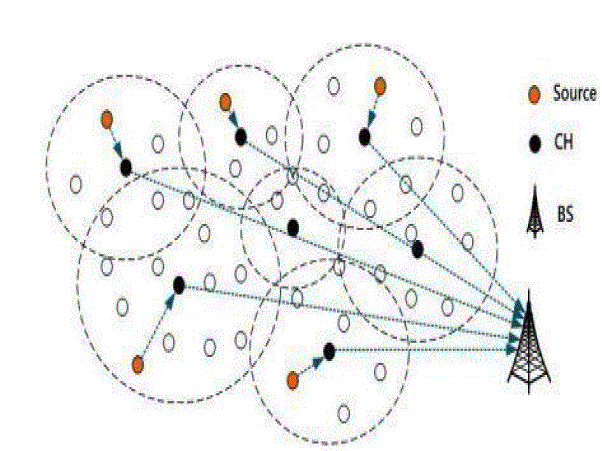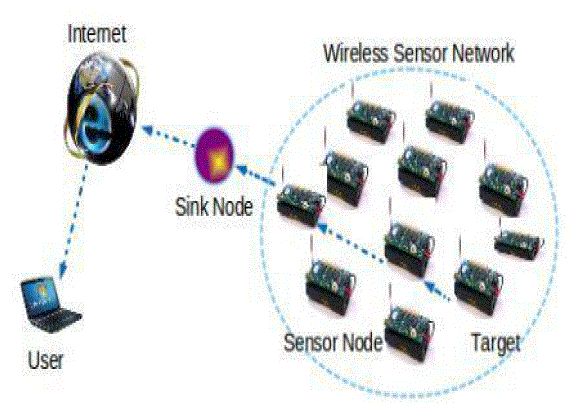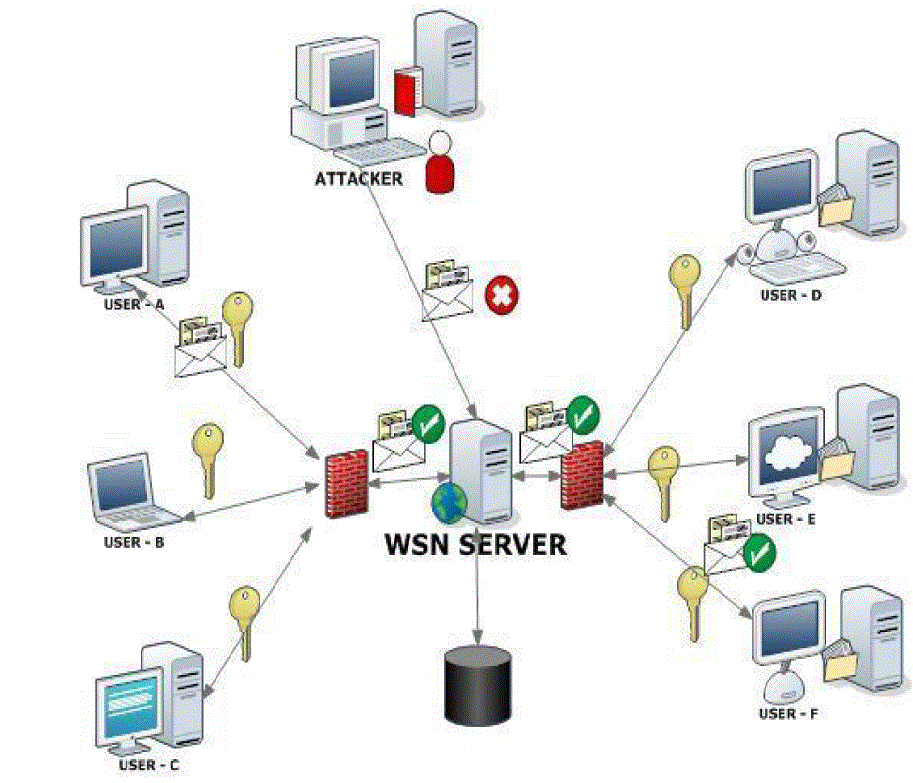Keywords |
| Wireless Sensor Networks; Security; Mobile polynomial pool; Static polynomial pool; Key
Distribution |
INTRODUCTION |
| A Wireless Sensor network is contains a huge number of sensor nodes that are deploy in a broad area with very low
power-driven sensor nodes [1]. The sensor networks are capable of be consumed in a various information and
telecommunications system applications. The nodes in WSN are very small devices among wireless communication
capability that can collect information like temperature, motion, light, sound, etc and progression different sensed
information and transfer it to the nearest other nodes to base station. The below Fig: 1 shows the scenarios of Wireless
Sensor Network. |
| One of the major design goals of Wireless Sensor Networks is to carry out the data communication and prevents
connectivity degradation [2]. Data sensing and reporting in WSNs is depending on the application. The Wireless Sensor
networks are having different requirements rather than other wireless networks [3]. |
| The design of the routing protocols for Wireless Sensor Networks are challenging because of the several network
constraints. This suffers from the limitations of several network resources, for e.g., central processing unit, energy,
storage and bandwidth. |
| A. Basic Characteristics of Wireless Sensor Networks: |
| Wireless Sensor Networks contains the following Characteristics: |
| Self Healing, |
| Self Protection Capabilities, |
| Self Configuration and |
| Self Optimization |
| B. Applications of Wireless Sensor Networks: |
| In below we given some classic applications for Wireless Sensor Networks, |
| • Environmental applications: Monitoring a large geographic area with human being there. |
| • Military applications: To monitor and track the enemy troop movement or movements of terrorists. |
| • Industrial applications: The low cost sensor nodes [4] are attached to the equipment to monitor performance. |
| • Medical applications: Tracking of the functioning of the heart |
| • Urban applications: Used in the security monitors in shopping malls, etc. |
II. PROBLEM STATEMENT |
| The multiple sensor nodes are necessary to overcome environmental obstacles like obstructions, line of sight (LOS)
constraints etc [5]. The Base station first sends the request to particular sensor node through all intermediate sensor
nodes in WSN. The sensor node when get the request it check the key and verify it. If it’s correct then only it shares the
data to base station. The sensed data often need to be sent back to the base station for analysis. All sensor nodes use the
keys to communicate data. But the attacker can create large number of keys and using that key too control entire
networks or any sensor node and then start to data communication to any other sensor nodes. |
| The Base Station (BS) can send the request to any one sensor node means the attacker can send the data of any other
node and can control the whole network. So the sink node and BS cannot get proper information or data. The structure
of Wireless Sensor Networks with target node and sink node are shown in Fig: 2. |
III. PROPOSED SYSTEM |
| The proposed system uses a high security framework called Three-tier Security Scheme using pair-wise key
distribution in Wireless Sensor Networks (WSNs). These frameworks use two different key pools to provide security for all sensor nodes in Wireless Sensor Networks. The general three-tier security framework for authentication and
pair-wise key establishment is works based on the polynomial pool-based key predistribution scheme [6]. |
| This scheme can be uses two separate polynomial pools: |
| A. Mobile Polynomial pool- It’s authenticates between sink nodes and stationary access nodes. |
| B. Static Polynomial pool- It’s authenticated and setup the keys between the sensor nodes and stationary access nodes. |
| Using these two different key pools and having some sensor nodes that carry unique keys from the mobile key pool will
make it more difficult the attacker to launch the mobile sink replication attacks in the wireless sensor networks by
capturing only a few arbitrary sensor nodes. |
| This Three-tier security scheme uses different keys for all sensor nodes i.e., any nodes cannot uses the same keys.
These keys are generated in one key pool [7]. If any two nodes can communicates through a common shared key. The
Three-tier security scheme can use the middle tier to compare two nodes and allow correct node to send correct data to
sink node and Base Station (BS). |
IV. CONCLUSION AND FUTURE WORK |
| The three-tier security framework is uses the pair-wise key establishment between mobile sink node and sensor
nodes. So it can get the data or information from correct sensor node. Because it uses the node comparison and
authentication using predistributed key scheme. In future work, we investigate the new approach for provide high
resiliency and eliminating the threats impose by captured keys by revoking |
Figures at a glance |
 |
 |
 |
| Figure 1 |
Figure 2 |
Figure 3 |
|
| |
References |
- D. Liu, and P. Ning, âÃâ¬ÃÅLocation-Based Pair wise Key Establishments for Static Sensor Networks,âÃâ¬Ã Proceedings of First ACM Workshop Security Ad Hoc and Sensor Networks, 2003.
- H. Deng, W. Li, and D.P. Agrawal, âÃâ¬ÃÅRouting Security in Wireless Ad Hoc Networks,âÃâ¬Ã Proceedings of IEEE Communication Magazine, pp. 70-75,2002.
- C. Intanagonwiwat, R. Govindan, and D. Estrin, âÃâ¬ÃÅDirected Diffusion: A Scalable and Robust Communication Paradigm for Sensor Networks,âÃâ¬ÃÂProc. Mobicom, pp. 56-67, 2000.
- I.F. Akyildiz, W. Su, Y. Sankarasubramaniam, and E. Cayirci, âÃâ¬ÃÅWireless Sensor Networks: A Survey,âÃâ¬Ã Computer Networks, vol. - 38, no. 4, pp.393-422, 2002.
- ArchanaBharathidasan, and Vijay Anand Sai Ponduru, âÃâ¬ÃÅSensor Networks: An Overview,âÃâ¬Ã Department of Computer Science University ofCalifornia, Davis, CA 95616.
- D. Liu, P. Ning, and R.Li. Establishing, âÃâ¬ÃÅPairwise Keys in Distributed Sensor Networks,âÃâ¬Ã Proc. 10th ACM Conf. Computers and Comm. Security (CCS âÃâ¬Ãâ¢03), pp. 52-61, Oct. 2003.
- L. Eschenauer, and V.D. Gligor, âÃâ¬ÃÅA Key-Management Scheme for Distributed Sensor Networks,âÃâ¬Ã Proc. ACM Conf. Computer Comm. Security (CCS âÃâ¬Ãâ¢02), pp. 41-47, 2002.
|